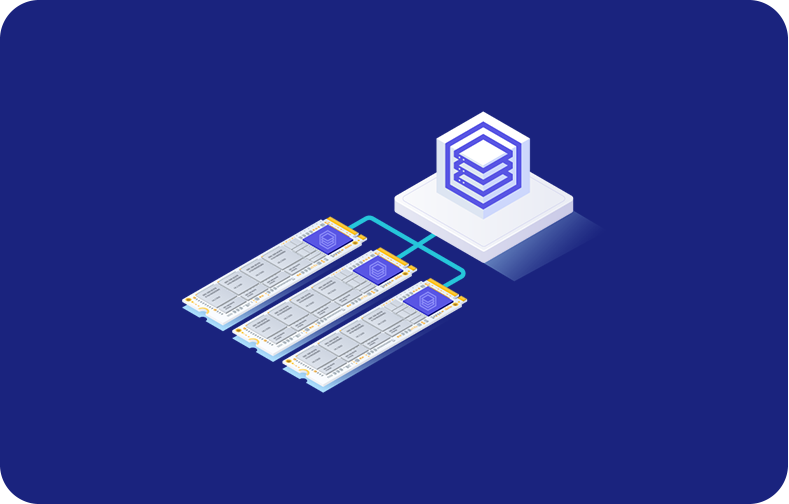Comprehensive Guide for Network File Systems (NFS): A User Walk-Through

In basic terms, a Network File System, or NFS, is a method by which a user accesses files over a network to feel that access to storage is as transparent as it would be when accessing local storage.
The primary objective of NFS is to access shared files and easily interchange files between different computing devices over a network connection. It provides an easy way to share files, dramatically reducing the complexity of overall data handling and making it possible for users and systems to share files within enterprises or over the Internet.
-
- History and Evolution
- Key Components and Architecture of NFS
- How NFS Works
- NFS on Debian Linux
- NFS Features in Art Style
- Benefits of Using NFS
- Disadvantages of utilizing NFS
- Common Use Cases
- Performance Optimization
- Security Features
- Future Trends and Development
- Alternatives to Network File System
- Network File System and VPSServer
Network File System is crucial for modern computing, enabling seamless collaboration, resource optimization, cross-platform compatibility, scalability, security, and diverse use cases.
It supports teamwork with shared file access, reduces costs through centralized storage, ensures compatibility across OSes, scales efficiently, and prioritizes data security. Its versatility suits various applications, from basic file sharing to complex cloud setups, making it indispensable across industries.
History and Evolution
Network File System could only be considered "an oldie in a good way," so to speak. Its history dates back to the 1980s, with initial development by Sun Microsystems. The basis for the NFS protocol was remote access to a network, which eliminates the gap between different systems and offers the possibility of sharing files transparently in a distributed computing environment.

The Network File System has evolved significantly through its major versions: NFSv2 laid the groundwork for remote file access in the 1980s, emphasizing simplicity via UDP. NFSv3 in the mid-1990s improved performance and introduced ACLs.
NFSv4 in the early 2000s revolutionized it with a stateful protocol, enhanced security, and advanced locking mechanisms. Subsequent versions like NFSv4.1 and NFSv4.2 built on this, introducing parallel NFS for distributed access, more robust security protocols, and performance enhancements, reflecting its continuous adaptation to evolving network needs and technological advancements.
Key Components and Architecture of NFS

NFS Client
The NFS client is responsible for accessing or working with files and directories hosted remotely on servers. It runs inside the OS of the client machine; it uses NFS protocols to request services from servers across the network. It translates protocol requests into local filesystem requests, giving transparent access to remote files as if they were local.
NFS Server
It is a server on which shared files and directories are made available for NFS clients over the network. This is driven by the NFS server software, which executes the protocol and responds to the client's request to perform read, write, or file lock operations on files. The server looks after the access permissions and hierarchy within the file system, ensuring data integrity and consistency between clients.

NFS Protocol
The NFS protocol describes rules and procedures for communicating with clients and servers. It defines how file operations are performed on the network, such as data transfer, file locking services, authentication, and error handling. The protocol comes in various versions, such as NFSv3 and NFSv4, which were developed to add new features and outstanding capabilities as network and security needs change.
How NFS Works
NFS works in a client-server model. Clients access shared files and directories on a server over a network. This interaction encompasses all the basic operations: reading, writing, and file locking.

Read Operations: When you request to read a file, it takes the data from its storage and transmits it to the client, often optimizing performance via caching for frequently accessed files.
Write Operations: Writing data entails sending updates to the NFS, which then processes and stores the changes, ensuring data consistency and integrity across multiple accesses.
Its locking mechanisms maintain data coherence by preventing conflicts when multiple clients modify the same file concurrently. This orchestration within a client-server framework establishes NFS as a reliable solution for seamless file sharing and efficient data management in networked environments, bolstering collaborative workflows and system reliability.
NFS on Debian Linux
Debian Linux seamlessly integrates NFS with its built-in client and server components, simplifying setup and configuration.

To set up an NFS server, install the software using apt, configure shared directories in /etc/exports, and start the NFS server service (nfs-server). On client systems, install packages via apt, mount NFS shares using the mount command or /etc/fstab, and access shared files seamlessly within the local file system.
Security measures include using NFSv4 with Kerberos or LDAP for authentication, implementing firewall rules for access control, and considering NFSv4 encryption for secure data transmission. Leveraging NFS on Debian Linux ensures efficient and secure file-sharing environments, enhancing collaboration and data management across Linux systems.
NFS Features in Art Style
Cross-Platform Compatibility: NFS's ability to seamlessly integrate across different operating systems is akin to blending various art mediums. Just as artists combine different tools and techniques to create masterpieces, it facilitates collaboration among artists using diverse platforms, ensuring compatibility doesn't hinder creative workflows.

Scalability and Performance Benefits: Much like the versatility needed in art projects, it provides scalable and high-performance solutions tailored to the demands of handling large electronic arts and complex creative endeavors. This ensures artists can focus on their work without storage or performance constraints.
Centralized Management for Efficient Creativity: Its centralized management capabilities resonate with the need for artists to organize and access creative assets efficiently. Just as an organized studio enhances productivity, NFS's centralized approach streamlines access to shared resources, optimizing collaborative efforts and fostering artistic innovation.
Benefits of Using NFS
Increased user collaboration: The Network File System supports simple collaboration, as it shares access to files and resources with the devices connected to the network. This allows real-time teamwork, which enhances project productivity and efficiency.
Lower Storage Costs through Resource Sharing: Centralized file storage and shared access in NFS help optimize an organization's storage. It reduces redundancy in many ways, reducing storage costs and data management processing.
Easier Management of Data: It provides data manageability in a much easier way through a central platform of file storage and accessibility. Using this, an administrator can maintain uniform access controls, centrally control permissions, and maintain data consistency across the network.

Disadvantages of utilizing NFS
Security Challenges over Open Networks: Over open networks, such as the Internet, It is exposed to a multitude of security challenges, in which data transmission remains open to interception or unauthorized access. Strong encryption, security authentication mechanisms, and network segmentation strategies reduce these risks.
Performance Bottlenecks in Large-Scale Deployments: Performance bottlenecks due to NFS can be seen in large-scale deployments with a large number of concurrent users or while it is subjected to high demands of access to data.
In general, the system's responses can be affected because of issues related to network congestion, load, or storage limits. Then, in this case, crucial strategies for achieving good performance are load balancing techniques, optimization of network configuration, and scaling of storage infrastructure.
Common Use Cases
Sharing Data in the Enterprise
This is the most common use of a network file system, which is used to share data between workgroups and departments in an enterprise. This allows users to access and work on shared files and resources residing on servers, thereby enabling proper processes at work and knowledge sharing among users within an organization.
Media and Content Streaming Applications
Where applications are required to access large volumes of multimedia files and deliver them in real time, it has a great impact. The best way to deliver high-speed access to media files is by using NFS, hence ensuring a good experience in media streaming for application end-users over various platforms.
Virtualization and Cloud Storage Setups
Virtualization and cloud storage mean the effective achievement of file storage solutions that are easily manageable, reliable, and scalable to virtual machines and instances in the cloud. This allows VMs to access shared storage resources that enable resource dynamism, data migration, and centralized management in virtualized and cloud-based infrastructures.
Performance Optimization
Bandwidth Management
TCP vs. UDP: In other words, both of them are transport layer protocols between the user and the server. Whether it will be NFS over TCP or UDP, that choice comes from the requirement for either robustness in the network or better performance.
TCP provides reliable data transfer with error checking and re-transmission. If the network conditions are relatively constant, UDP is for fast data transmission but has no built-in error handling. That seems fine for high-speed, low-latency networks, where an occasional packet dropped or corrupted is acceptable.
Jumbo Frames: This type of operation allows the use of bigger Ethernet frame sizes in the network configuration, cutting back on overhead and allowing NFS traffic to flow more efficiently. It generally increases throughput and diminishes network latency, particularly in environments with very high data movement.
Strategies for Speeding up Caching
Client-Side Caching (NFS CacheFS): Read performance is increased due to the help of mechanisms in client-side caching like NFS CacheFS, where most of the frequently required data resides on the machine itself. Then, there will not be a need for the system to repeat network calls often, so the total response of the system will be better, and traffic will be less.
Server-side Caching (NFS CacheFS): This is yet another mechanism at the level of the server used for performance improvements by server-based data caching. This is useful, especially for caches that are caching the data to be read by clients. This reduces the number of disk I/O for access and improves the response time of workloads with a great deal of reading.
These performance optimization techniques for deployments can achieve faster data transfer speeds, less latency, and increasingly efficient systems that meet the needs of many applications and workflows today.
Security Features
Ways of Authentication and Access Control
Kerberos Authentication: Including Kerberos authentication is a step further in enhancing the security of the Network File System. This requires the users to validate themselves before accessing the resources. Therefore, Kerberos can be implemented using tickets and encryption for secure authentication, therefore making it harder for uninvited users to break in.
LDAP integration: It can easily be integrated with the Lightweight Directory Access Protocol (LDAP) for centralized user authentication and access control management. This can easily be applied using the LDAP directories for consistency in access policy across file system servers to facilitate user administration and enhance security.
Data Protection Using Encryption
Packed in with NFSv4 is the ability to ensure that data does not get lost in transit over a network. With NFSv4, encryption will also provide a way to apply security to data before sending it over the wire; it thus ensures that data will be in an encrypted manner, free from snooping and other unauthorized interceptions.
VPN tunneling, therefore, is a means of a secure and encrypted connection either over the Internet or any other untrusted network between the clients and the servers. It further adds another layer of confidentiality and integrity to the traffic of a VPN, thereby reducing related risks of security issues because of data exposure on the public network.
Future Trends and Development
Remote Direct Memory Access(RDMA) Protocol
NFS over RDMA has been known to change technology for a long time, with the ability to raise data speed and reduce latencies between clients and servers. RDMA bypasses conventional networking layers, bestowing systems with direct memory access to one another. This feature may help improve performance by huge margins, especially on data transfer of large-scale and heavy-demand workloads.
Containerization and NFS Integration
The link to NFS has been identified among the basic issues in the development of future NFS in the generalization of modern containerization technologies—Docker and Kubernetes. It represents a solution to stateful containerized applications that need persistent storage; it offers persistence and data access across instances of the containers by effectively orchestrating storage resources within the clusters of containers.
Machine Learning Applications
ML techniques and algorithms will play a significant role in integrating optimized performance with NFS resource allocation and data management.
It presents a detailed explanation of how ML algorithms can assist in understanding the usage pattern of NFS, giving hints about resource demand in advance and adapting caching strategy, access control, and storage allocation dynamically to encourage overall efficiency, scalability, and reliability of NFS in such dynamic computing environments.
It will help deployments stay in line with the ever-increasing IT needs through the adoption of future trends and developments that can improve performance, scalability, and security—in an organic, seamless fit with modern technologies such as containerization and RDMA for optimized data management and access across varied computing environments.
Alternatives to Network File System
Distributed File Systems: Ceph and GlusterFS
Ceph Features: Ceph is an exorbitantly scalable, fault-tolerant distributed storage system for the most enormous quantifications of data. Storage features include object storage, block storage, and file storage.
This is a very relevant and fit technology for massive deployment, either cloud infrastructures or applications with enormous data. This is because its architecture ensures data redundancy and the distributed nodes' reliability based on the Reliable Autonomic Distributed Object Store (RADOS) architecture.
GlusterFS Features: GlusterFS is a distributed file system designed for simplicity and scalability. It has one unified global namespace, allowing the aggregation of different storage pools across several servers. The distributed architecture in GlusterFS allows for linear scaling by adding storage nodes as required, making it suitable for the growing storage demands typical of dynamic environments.
Cloud Storage – AWS EFS and Azure Files
Features of Amazon Elastic File System (EFS): It supports seamless scalability in the AWS cloud and easy integration with other customers, given its integration facility with other AWS services. It also supports the NFSv4 protocol, meaning it can work with a shared file system based on NFS, which the application uses.
Amazon EFS is ideal for a wide variety of workloads that require automatic scaling and dynamically resilient file storage. It is automatically scalable, highly available, redundant across multiple availability zones, and very durable data.
Azure File Features: These are fully managed file shares with protocols such as NFS and SMB, which means they are fully compatible with Windows, Linux, and macOS. Naturally, this puts them in Azure Files, which has features such as snapshotting, access control, and integration with Azure Active Directory for identity management. It is very supportive of high availability, scalability, and data encryption.
Network File System and VPSServer
NFS, Network File System, and VPSServer are interrelated in terms of data storage and access in networked environments. As a protocol, it enables seamless sharing and access to files from any networked device.
Its clients can access shared files and directories hosted on an NFS server. On the other hand, VPSServer provides Virtual Private Servers (VPS) — that is, stand-alone computing environments with private resources like CPU, RAM, and storage.
The synergy between NFS and VPSServer allows seamless file sharing and data access among virtualized systems. Integrating NFS in VPS environments ensures efficient collaboration, data consistency, and centralized management. This integration enhances data storage, access control, and scalability for virtualized workloads and applications.
Frequently Asked Questions
What is a Network File System, and how does it work?
It is the protocol of a distributed network file system that provides a user with access to files. It is implemented on a client machine so that the files seem to be locally located on the system. The usual operation is done through a client-server model, where a client talks to an NFS server to perform operations on files, such as read, write, and file locking.
Which version of NFS are there, and what are the characteristic differences?
It comes in multiple versions, NFSv2, NFSv3, NFSv4, NFSv4.1, and NFSv4.2, each having performance improvements, more security through the encryption and authentication method, more outstanding file support for considerable size, and further protocol development for greater efficiency over the network.
How do you implement and configure a Network File System in a networked environment?
Configuration of servers and clients, settings of exports on the server to define the shared directories, and setting up management for NFS mount point on the system are among the NFS-specific configurations, settings, access controls, caching options, and performance tuning parameters according to workload requirements.
What are some of the security mechanisms that need to be in place while implementing a Network File System?
Among the key security measures are enforceable authentication mechanisms, like Kerberos or LDAP integration, rest and flight encryption, access control lists for setting permissions, and secure NFS access on non-trusted networks using VPN tunneling.











